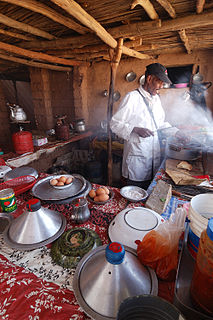
Cooking, cookery, or culinary arts is the art, science and craft of using heat to prepare food for consumption. Cooking techniques and ingredients vary widely, from grilling food over an open fire to using electric stoves, to baking in various types of ovens, reflecting local conditions.

A kiln is a thermally insulated chamber, a type of oven, that produces temperatures sufficient to complete some process, such as hardening, drying, or chemical changes. Kilns have been used for millennia to turn objects made from clay into pottery, tiles and bricks. Various industries use rotary kilns for pyroprocessing—to calcinate ores, to calcinate limestone to lime for cement, and to transform many other materials.
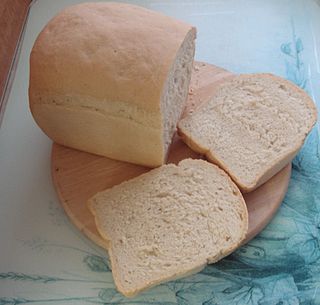
Baking is a method of preparing food that uses dry heat, typically in an oven, but can also be done in hot ashes, or on hot stones. The most common baked item is bread but many other types of foods can be baked. Heat is gradually transferred "from the surface of cakes, cookies, and pieces of bread to their center. As heat travels through, it transforms batters and doughs into baked goods and more with a firm dry crust and a softer center". Baking can be combined with grilling to produce a hybrid barbecue variant by using both methods simultaneously, or one after the other. Baking is related to barbecuing because the concept of the masonry oven is similar to that of a smoke pit.

A microwave oven is an electric oven that heats and cooks food by exposing it to electromagnetic radiation in the microwave frequency range. This induces polar molecules in the food to rotate and produce thermal energy in a process known as dielectric heating. Microwave ovens heat foods quickly and efficiently because excitation is fairly uniform in the outer 25–38 mm(1–1.5 inches) of a homogeneous, high water content food item.

A hearth is the place in a home where a fire is or was traditionally kept for home heating and for cooking, usually constituted by at least a horizontal hearthstone and often enclosed to varying degrees by any combination of reredos, fireplace, oven, smoke hood, or chimney. Hearths are usually composed of masonry such as brick or stone. For centuries, the hearth was such an integral part of a home, usually its central and most important feature, that the concept has been generalized to refer to a homeplace or household, as in the terms "hearth and home" and "keep the home fires burning". In the modern era, since the advent of central heating, hearths are usually less central to most people's daily life because the heating of the home is instead done by a furnace or a heating stove, and cooking is instead done with a kitchen stove/range alongside other home appliances; thus many homes built in the 20th and 21st centuries do not have hearths. Nonetheless, many homes still have hearths, which still help serve the purposes of warmth, cooking, and comfort.

Cookware and bakeware is food preparation equipment, such as cooking pots, pans, baking sheets etc. used in kitchens. Cookware is used on a stove or range cooktop, while bakeware is used in an oven. Some utensils are considered both cookware and bakeware.

Outdoor cooking differs substantially from kitchen-based cooking, the most obvious difference being lack of an easily defined kitchen area. As a result, campers and backpackers have developed a significant body of techniques and specialized equipment for preparing food in outdoors environments. Such techniques have traditionally been associated with nomadic cultures such as the Berbers of North Africa, the Arab Bedouins, the Plains Indians, pioneers in North America, and indigenous tribes in South America. These methods have been refined in modern times for use during recreational outdoors pursuits.

An oven is a tool which is used to expose materials to a hot environment. Ovens contain a hollow chamber and provide a means of heating the chamber in a controlled way. In use since antiquity, they have been used to accomplish a wide variety of tasks requiring controlled heating. Because they are used for a variety of purposes, there are many different types of ovens. These types differ depending on their intended purpose and based upon how they generate heat.
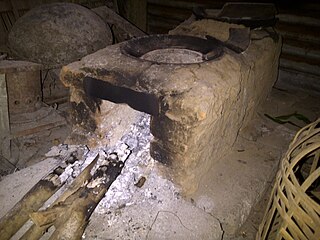
A stove is a device that burns fuel or uses electricity to generate heat inside or on top of the apparatus. It has seen many developments over time and serves the main purpose of cooking food.

A kitchen stove, often called simply a stove or a cooker, is a kitchen appliance designed for the purpose of cooking food. Kitchen stoves rely on the application of direct heat for the cooking process and may also contain an oven, used for baking. "Cookstoves" are heated by burning wood or charcoal; "gas stoves" are heated by gas; and "electric stoves" by electricity. A stove with a built-in cooktop is also called a range.

A central heating system provides warmth to a number of spaces within a building and optionally also able to heat domestic hot water from one main source of heat. It is a component of heating, ventilation, and air conditioning (HVAC) systems, which can both cool and warm interior spaces.

Fulacht fiadh is the name given to one of many burned mounds, dating from the Bronze Age, found in Ireland. Most surviving examples consist of a low horseshoe-shaped mound of charcoal-enriched soil, and heat shattered stone, with a cooking pit located in a slight depression at its centre. In ploughed fields, they are apparent as black spreads of earth interspersed with small sharp stones.

A banya is originally a Russian steam bath with a wood stove. It is considered an important part of Russian culture. The bath takes place in a small room or building designed for dry or wet heat sessions. The steam and high heat make the bathers perspire. Genders were traditionally segregated in the banya, with separate rooms for the sexes.

An earth oven, ground oven or cooking pit is one of the simplest and most ancient cooking structures. At its most basic, an earth oven is a pit in the ground used to trap heat and bake, smoke, or steam food. Earth ovens have been used in many places and cultures in the past, and the presence of such cooking pits is a key sign of human settlement often sought by archaeologists. Earth ovens remain a common tool for cooking large quantities of food where no equipment is available. They have been used in various civilizations around the world and are still commonly found in the Pacific region to date.
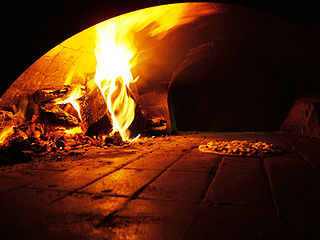
A masonry oven, colloquially known as a brick oven or stone oven, is an oven consisting of a baking chamber made of fireproof brick, concrete, stone, clay, or cob. Though traditionally wood-fired, coal-fired ovens were common in the 19th century, and modern masonry ovens are often fired with natural gas or even electricity. Modern masonry ovens are closely associated with artisan bread and pizza, but in the past they were used for any cooking task involving baking. Masonry ovens are built by masons.
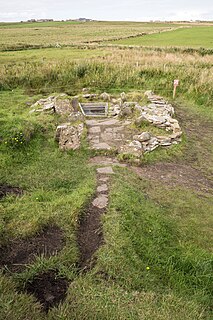
A burnt mound is an archaeological feature consisting of a mound of shattered stones and charcoal, normally with an adjacent hearth and trough. The trough could be rock-cut, wood-lined or clay-lined to ensure it was watertight. Radiocarbon dates vary quite widely, the earliest being late Neolithic, with clusters of dates between 1900 and 1500 BC and 1200–800 BC, with some outliers in the Iron Age. There are also some dates that go into the Early Middle Ages. The technology used at burnt mounds has much greater antiquity and is found from the Palaeolithic onwards.
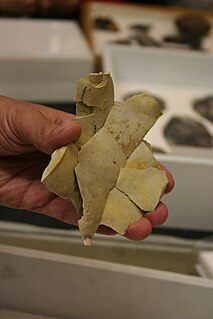
In archaeology, debitage is all the material produced during the process of lithic reduction - the production of stone tools and weapons by knapping stone. This assemblage may include the different kinds of lithic flakes and lithic blades, but most often refers to the shatter and production debris, and production rejects.

A tabun oven, or simply tabun, is a clay oven, shaped like a truncated cone, with an opening at the bottom from which to stoke the fire. Built and used in biblical times as the family, neighbourhood, or village oven, tabun ovens continue to be built and used in parts of the Middle East today. Nowadays, some of the tabun ovens are also made out of metal.
The 1958 Ecuador–Colombia earthquake struck the coastal regions of Ecuador and Colombia on January 19 with a surface wave magnitude of 7.6 at 9:07 local time. Approximately 30 percent of Esmeraldas (Ecuador) was destroyed, including the children's department of the hospital, where three children died. In all, 111 persons died and 45 were injured as a result of the earthquake. Water mains were broken and power transmission lines were damaged. The Esmeraldas-Quito highway collapsed at many places. Many other roads of the country were made impassable by cracks and fallen trees. According to press reports, a landslide from the slopes of the Andes at Panado village buried a hundred people. The earthquake was destructive in the cities on the northern coast of the country and was strong from Latacunga to Quito, Ibarra and Tulcán. It was felt at Guayaquil.

The primitive clay oven, or earthen oven / cob oven, has been used since ancient times by diverse cultures and societies, primarily for, but not exclusive to, baking before the invention of cast-iron stoves, and gas and electric ovens. The general build and shape of clay ovens were, mostly, common to all peoples, with only slight variations in size and in materials used to construct the oven. In primitive courtyards and farmhouses, earthen ovens were built on the ground.


















